Myringotomy Tubes
Myringotomy Tube Surgery in Castle Rock, CO
Painful ear infections can cause excessive fluid that may lead to hearing loss and speech issues. Castle Rock Ear Associates provides myringotomy tubes for patients in Castle Rock, CO and Douglas County. Myringotomy tubes can provide significant relief for individuals suffering from chronic ear infections or persistent fluid buildup in the middle ear. Reach out to us to learn more.

What Are Myringotomy Tubes?
Myringotomy tubes, also known as tympanostomy tubes, pressure equalization tubes, or ventilation tubes, are small, hollow cylinders made of materials like plastic, metal, or Teflon. These tubes are surgically inserted into the eardrum to ventilate the middle ear and allow trapped fluid, such as pus, blood, or water, to drain out. There are two main types of myringotomy tubes:
- Short-Term Tubes: Smaller in size, these tubes typically stay in place for six months to a year before naturally falling out on their own.
- Long-Term Tubes: Designed for extended use, these tubes are larger and often secured with flanges. They may require removal by a specialist if they do not fall out naturally.
Who Needs Myringotomy Tubes?
Ear tube surgeries are the most common pediatric procedures conducted under anesthesia, with over 500,000 being performed annually. Myringotomy tube surgery is often recommended for the following groups:
- Children with recurrent middle ear infections or fluid buildup in the ears that leads to hearing loss, speech or balance issues, or chronic discomfort.
- Adults experiencing similar issues, such as persistent fluid buildup, chronic ear infections, or barotrauma caused by changes in air pressure.
- Individuals with specific conditions like Down syndrome, cleft palate, or structural issues affecting the eustachian tube, which prevents normal ear function and drainage.
How Is Myringotomy Tube Surgery Performed?
Myringotomy tube placement is a straightforward outpatient procedure often completed in less than 15 minutes. You can expect the following during myringotomy tube placement:
- Anesthesia is administered, typically general anesthesia for children and local or light general anesthesia for adults.
- A small incision is made in the eardrum using a surgical microscope and a scalpel or laser.
- Fluid trapped in the middle ear is gently suctioned out.
- A myringotomy tube is inserted into the incision to keep the opening clear and allow continuous ventilation of the middle ear.
- An adenoidectomy may also be performed for patients needing repeat myringotomies. This is thought to reduce the recurrence of ear infections and the need for future surgeries.
Benefits of Myringotomy Tubes
Myringotomy tubes are an excellent way to boost ear health. Some of the most significant benefits of myringotomy tubes include:
- Improved Hearing: Resolves hearing loss caused by fluid buildup.
- Reduced Antibiotic Use: Less reliance on oral antibiotics for ear infections.
- Fewer Ear Infections: Helps lower the risk of ear infections in patients.
- Prevented Speech Delays: Crucial in children during language development.
- Better Sleep and Behavior: Relieves discomfort and promotes overall well-being.
Risks of Myringotomy Tubes
As with any surgery, there are risks in myringotomy surgery. Though minimal, the risks include:
- Perforation: A small chance that the eardrum may not heal properly after the tube falls out.
- Scarring: Repeated infections or multiple tube placements may lead to scarring, typically without hearing issues.
- Ear Infection: Occasional infections may persist but are often easier to treat.
- Premature Tube Expulsion: The tube may fall out too soon, causing fluid buildup.
- Blocked Tubes: The tubes may get blocked by earwax or debris.
What to Expect After Myringotomy Tube Surgery
Immediately after surgery, most patients experience little to no pain. They may notice some grogginess or mild nausea. Hearing improvement is often immediate as trapped fluid is removed. Drainage from the ears may continue for 2–3 days. Cotton placed in the ears should be changed regularly. Follow-up appointments will monitor the tube’s placement, function, and overall ear health.
Precautions After Myringotomy Tube Placement
Most tubes naturally fall out within 6–12 months, and the eardrum usually heals without issues. Some of the best ways to enhance your experience with ear tubes include wearing them for swimming or bathing to prevent bacteria from entering the tubes, especially in lakes or unclean water. Some patients may need antibiotic ear drops to prevent post-operative infections.
Call Castle Rock Ear Associates in Castle Rock, CO
You deserve expert care tailored to your individual needs for hearing health. At Castle Rock Ear Associates, our professionals specialize in myringotomy tube placement and a wide range of other ear, nose, and throat treatments. Whether it’s your first consultation or you’re managing recurrent ear infections, we’re here to help. Connect with our team in Castle Rock, CO to schedule an appointment.
Castle Rock Ear Associates
Address
4344 Woodlands Boulevard, Suite 240
Castle Rock, CO 80104
Phone: 720-408-9118
Fax: 720-547-9180
Email: contact@castlerockear.com
Hours of Operation
Monday: Closed
Tuesday: 8:00 AM – 5:00 PM
Wednesday: 8:00 AM – 5:00 PM
Thursday: Closed
Friday: 8:00 AM – 5:00 PM
